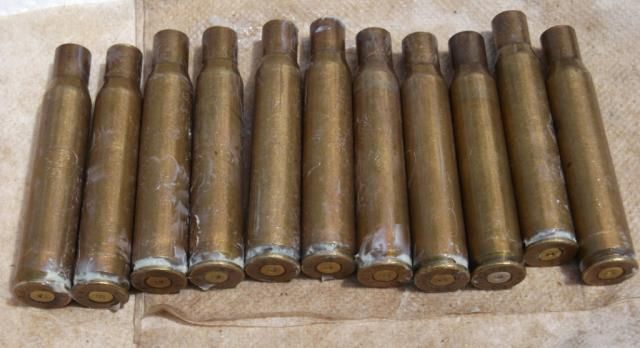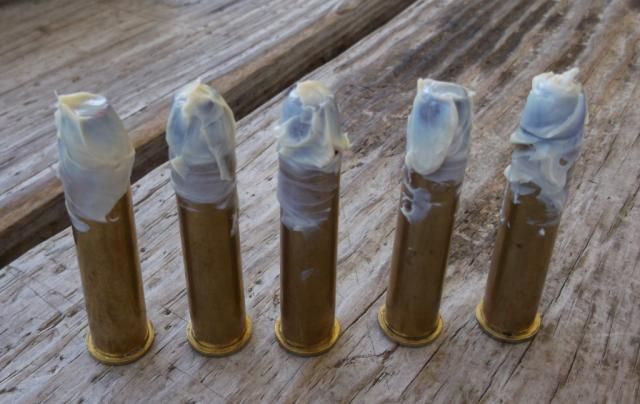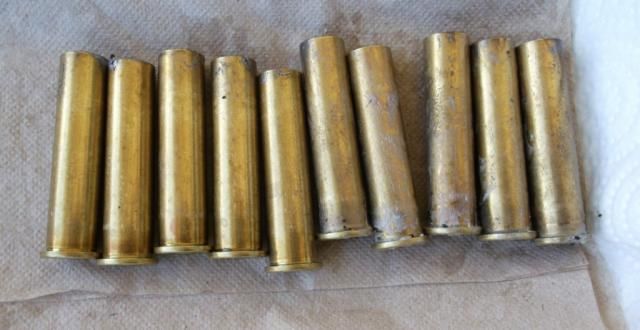I lube my rifle cases in a separate Thumler's Tumbler by tumbling the cases with a lube saturated patch. Sometimes I get too much lube on the cases, but regardless, just before the case goes into the sizing die, I wipe the neck and shoulder with a paper towel. I have eliminated all lube dents on my rifle cases by wiping.
Accumulation of lube in a sizing die will cause dents, will cause dents whether or not you have a weep hole or not. I have not found this to be true in my rifle chambers with grease or oil. This is due to the fact that in a rifle chamber, pressure inside the case causes the case to expand outward, and the thinnest parts of the case expand first. So regardless that oils and greases are incompressible (all things being considered this is true, but stack enough weight, fluids will compress) they still flow, and they flow within the chamber.
I tested the proposition that greases and oil pinch the case neck, prevent the case neck from expanding in the chamber, and thus "dangerously raise pressures".
Greased Rounds Test in 45/70 and 30-06
These rounds were fired as sighting shots, to zero rifle. Bullets and chamber absolutely free from grease.
30-06 M98 Match Rifle 26" 1-10 Wilson Barrel
168 gr Nosler Match 47.0 IMR 4895 thrown lot L7926 LC53 WLR (brass) OAL 3.30"
13 Aug 2014 T = 80 °F
Ave Vel = 2619
Std Dev = 29
ES = 72
High = 2644
Low = 2572
N = 5
I subsequently shot a group which the bullets were not greased, but there was most certainly some grease residue left in the chamber from previous rounds.
168 gr Nosler Match 47.0 IMR 4895 thrown lot L7926 FA60 CCI #34 OAL 3.30"
grease in chamber from greased rounds
13 Aug 2014 T = 80 °F
Ave Vel = 2691
Std Dev = 30
ES = 81
High = 2742
Low = 2661
N = 7
Group Size: 9 rounds on target. 89-4X on MR 31 target
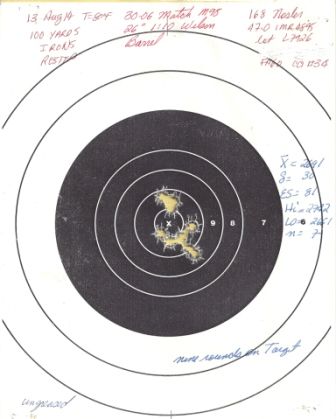
Greased bullets before and after firing
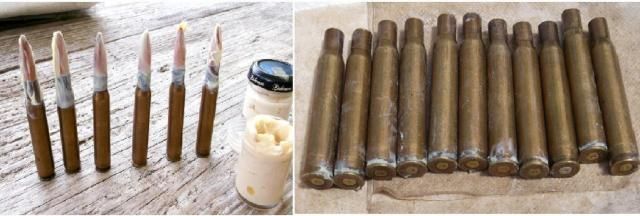
Initial rounds gave spurious reading across the chronograph which I wish they could have been true, for my chronograph was providing readings of 3000 fps. Velocities this high would be incredible for this load and bullet. If it had been real, and without pressure signs, the next thing I would have done was test the combination at long range. If the accuracy stayed excellent, if I could get 400 fps more velocity just by greasing the bullet, it would have been my secret. But I suspected instrumentation error and that is what it turned out to be. I moved the chronograph two feet + further from the muzzle and continued with my testing. On previous shooting sessions , when the chronograph was too close to the muzzle, or shooting magnum cartridges, or black powder, gunpowder residue crossed over the screens and created physically impossible velocity readings or displays of “err1”. As an example, I had to move my chronograph out to around 20 -25 yards to get any black powder musket velocities. The amount of powder residue blown out of the musket caused instrumentation error. For this test, I believe a mass of grease, or grease plume, created sensor error. This is why the number of shots on the targets do not correspond with the numbers in the chronograph data.
168 gr Nosler Match 47.0 IMR 4895 thrown lot L7926 FA/LC cases WLR (brass) OAL 3.30"
Greased to case shoulders by dip and twist with Lubriplate AA130
13 Aug 2014 T = 80 °F
Ave Vel = 2650 2658 2675
Std Dev = 16 2669 2642
ES = 46 2636 2629
High = 2675 2642
Low = 2629 2645
N = 8
Shot #5: grease beyond case shoulder, Shot #8 very heavily greased,

Shot #8, “Big Grease” before and after firing
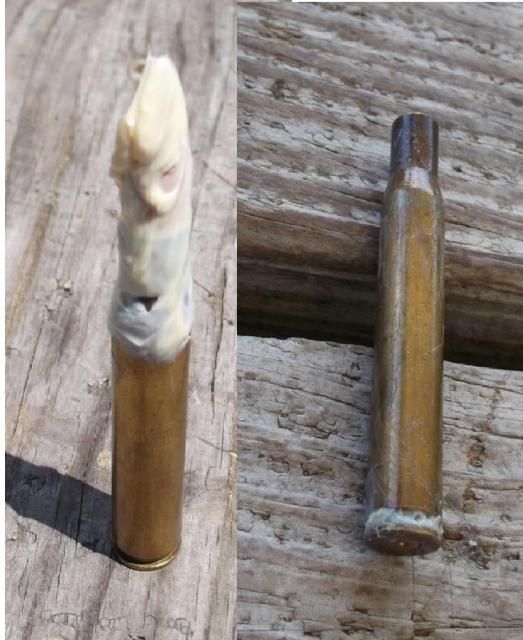
At 100 yards I am of the opinion that the grease on the bullets did not cause any difference in accuracy or velocity and I did not observe any pressure indications.
General Hatcher, in his book,
Hatcher's Notebook repeated an Army theory that greased bullets “dangerously” raised pressures because grease is incompressible, and that grease around the case neck “pinched” the case neck. This claim was made prior to the 1921 National Matches. While higher pressures should always give higher velocities, given that PV = nRT, pressure increases due to a thin grease layer do not follow a power law unless the volume is decreased exponentially. Without pressure measuring capabilities the only means I have of estimating pressure are inferences created after reviewing velocities, primer indications, (blown, leaking, primers, expanded primer pockets), and sticky bolt lift. I encountered none of these in any of my testing. It is possible that had I plugged the bore with grease, creating a bore obstruction, I would have experienced high pressure indications, but even so, given the huge mass of Lubriplate AA130 I put on the cartridges, if the Army’s claims were true about bullet pinching, I should have replicated the pressure problems. But I did not and I never have. This is not the first time I have shot greased cases, just the first time I have photographed greased cases, and it is the first time I have chronographed greased bullets. If, as the Army claimed, the case necks were prevented from expanding I should be able to measure this. I have measured the diameter of case necks, after firing with grease coatings, and the differences in diameter between dry and greased is within my measuring capabilities. I can’t measure a difference.
Primers of fired, greased rounds.

I would expect slightly higher velocities for the greased bullets, because ammunition technicians told me that in their laboratories they measured higher velocities at the same pressures for moly bullets. But given the small sample size in my shot strings, I can’t prove that one way or another. I look at the slight differences in velocities that I had for dry chamber, slightly greasy chamber, and greased chamber, as being all within the three sigma limits of what I would expect for that cartridge with that charge. That is, I don’t believe there is any significant velocity difference between any of my data strings, even though there are differences in the averages, but those are what you would normally see in velocity/pressure variations within the total population. So, based on velocities, I don’t see any evidence that grease on the case neck “pinches” the bullet.
What is totally wrong about the Army theory on “pinching” is the assumption that grease is immovable. Grease may be incompressible, but it is certainly not immovable. Under pressure, grease will flow. If it did not wheel bearings would have trouble rotating. With small arms cartridges the grease will flow because of the differences in metal thickness from the front and back of the case. Cases are thin at the front and thicken towards the case head. The whole combustion event is faster than human perception, thus is seems instantaneous, but it is not. Combustion pressures take a finite amount of time to climb to maximum pressure. It can be assumed at each moment in time, the pressure within the whole case is the same, but of course, as time increases, the pressures increase. As pressures increase, the thinner parts of the case expand first, and as pressures increase more, the thicker sections expand last. This has the effect of squeezing the grease, some into the throat, and some out the action. I tried measuring the OD of the case mouths, to measure film thickness, and the layer is so thin, I can’t measure a significant difference with my measuring equipment. Between dry and lubricated cases, the case mouth expansion measurements are indistinguishable.






